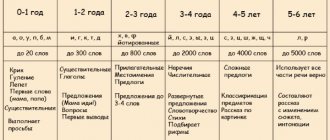Greetings, my dears! How important it used to be for me to find development tools for my children. There are different cartoons and cartoons, and of course I was looking on the Internet for something that could help my son and daughter develop while I was doing housework. My son really loved Soviet cartoons. Just look at “Umka is looking for a friend.” Memories of tenderness cause trembling in the heart. For my daughter, I included educational cartoons about shapes, letters, and speech development.
In this article I made a selection of what we ourselves grew up with. Of course, a lot of new things appeared, but the most favorite ones remained favorites. Fill your child’s time with useful viewing, because we, parents, sometimes want to escape from thoughts and questions: Why? And things that require concentration have not been canceled.
Educational cartoons for little ones
There are now a lot of educational cartoons for the little ones. And I would like to draw your attention to the fact that not all of them are as useful as they seem. While your baby is just a baby, please be extremely attentive to what is broadcast in cartoons. Of course, they are all made colorfully and at first glance entertaining. But you need to understand that each age has its own developmental characteristics and level of understanding. In addition, if you include cartoons through video hosting, other directions may appear in the recommendations feed.
I offer you this wonderful cartoon Tiny Love for your beloved kids who do not speak yet, but are just exploring the world. Dose your children's viewing time. Take care of their eyes.
First part. Duration is 28 minutes.
Second part. Duration is 29 minutes.
Pros and cons of the method
The plots of children's animation are designed in such a way that they develop curiosity, a sense of justice, and teach communication skills. Advantages of the cartoon genre:
- expansion of vocabulary;
- training in dialogue and monologue;
- familiarity with different intonation in sentences;
- development of phonemic hearing.
Almost no one follows the WHO recommendations of the last century, when a child was allowed to watch TV for only 30 minutes. Nowadays children are surrounded by gadgets, playing computer games, but before they read, drew or sculpted from plasticine more. Excessive video perception causes the following negative consequences:
- underdevelopment of the cortical parts of the brain;
- loss of communication skills;
- addiction;
- hyperactivity and aggression;
- speech disorders.
If your baby has problems with concentration or hyperactivity, try to limit the amount of time you watch TV. Drawing, reading, modeling, playing with cars or dolls together will be more useful.
Educational cartoons for children from 1 to 3 years old
Features of the development of a child from 1 to 3 years old are held under the slogan: I know, I can, I do! Based on this knowledge, we parents need to select educational material that would meet these needs. At this time, the foundations of the baby’s psyche are laid. By the first year of life, the vocabulary is about 10 words and by 3 years it reaches 1500.
Cartoons aimed at developing speech, memory and thinking can reinforce and help with these skills. Take this seriously. After all, a child can spend 20 minutes watching something that will harm him or spend this time learning new and useful things.
Impact Basics
Speech therapists, due to the relationship between the development of communication skills and the state of the child’s psyche, do not recommend putting children under 3 years old to watch animated films.
One of the conditions for the development of speech is that the child reaches the age when he can not only repeat (albeit distortedly) after an adult, but also understand the meaning of the word. In other cases, the information will not be consolidated; he will say something and forget. This is where parents come to the baby’s aid, explaining why this or that item is needed. From this point of view, no cartoon will provide him with so much knowledge. By copying facial expressions, gestures and remembering sounds and intonation, the baby gets acquainted with the world around him. After watching a cartoon he likes, he can also use new words in his vocabulary, but he will not identify them with the action and will not understand their meaning.
When watching TV, forced attention is formed; the child reacts to the brightness of the picture, sounds, images that change each other, that is, to stimuli. But at the same time he does not think or analyze. It is subsequently difficult to make such a child fall in love with reading; it is much easier to take information from the screen. But this does not mean a complete ban on cartoons, you just need to carefully select the content.
Think about it, preschool children (3-6 years old) spend up to 25 hours a week watching TV. The remaining time is devoted to communicating with others and playing games.
Stages of speech development in children:
- Up to a year. A gradual transition from individual sounds to humming, vocabulary by 12 months is up to 45 words. Pediatricians do not recommend getting involved in watching cartoons at this age. This is explained by the fact that at the early stage of speech development, its formation occurs through imitation of adults and their response. Emotions help reinforce skills. In addition, a child cannot copy the articulation and mouth movements of cartoon characters when pronouncing sounds.
- 1-3 years is the period of expansion of the active vocabulary due to not only nouns, but also verbs. The baby can already communicate using simple phrases. If you don't pay enough attention to it, your speech will be poor. The use of cartoons is possible on the recommendation of a speech therapist and under his supervision.
- From 3 to 7 years, in addition to oral communication, the baby is already able to consistently express thoughts, he intuitively understands his language. He still needs live communication, the ability to quickly remember everything, abuse of TV can lead to the appearance of jargon and filler words.
- From 7 to 17 years, oral speech is improved and written language is formed. If at this age a child lacks communication practice, speech development is delayed.
Educational cartoons about animals
For the youngest TV viewers, from a year old. The child will become familiar with different types of animals and their voices.
In this collection, kids will get acquainted with different animals and their babies, parts of the animals’ bodies, what they eat and where they live.
Here the baby will have an exciting journey to the zoo, he will learn the names of animals in Russian and English, as well as interesting features of each.
This cartoon offers a trip to a farm where domestic animals live happily, sing songs and play.
Here you will be asked to guess the animals that are riding in a tractor trailer while listening to funny songs.
And now about animals from different countries, what they like to eat, how they talk and how they communicate with each other.
A funny collection of cartoons tells about animals from different countries:
Cookies will introduce the child to different types of animals, simple words, and learn simple counting.
Viewing rules
It is unacceptable for a child to watch TV at close range.
- Some children sit in front of the TV screen for up to three hours a day, while they watch not only educational cartoons, but also those that negatively affect their psyche and sometimes mental development. Parents should give preference to educational pictures in which the characters teach the child numbers, letters, and introduce geometric shapes and colors. And if the hero travels to different continents or cities, this will help expand the child’s horizons. It is also important to select cartoons that develop the child’s logical thinking and imagination. It is necessary that they be as entertaining as possible, and the little one does not get bored while watching.
- It is important that there is no profanity, unclear information, or complex dialogues. Ideally, the animated film contains simple dances, funny songs, adventures, and jokes that a two-year-old child can understand.
- Remember that you need to dose out cartoons and sitting in front of the TV screen. It is not recommended for a two-year-old child to be near the TV for more than an hour a day, and watching cartoons should have breaks. Sitting in front of a screen for a long time contributes to deterioration of vision and negatively affects the baby’s nervous system.
- Before showing a cartoon to your little one, be sure to watch it yourself, make sure that it really has a teaching and educational basis, and that there is no profanity or incomprehensible scenes.
- It is ideal if the child watches the first cartoon together with one of the parents. After all, it is very important that an adult can assess the baby’s reaction to what is happening. After the little one watches the cartoon, it is advisable to discuss with him the actions of the characters and the plot.
- Don't forget that watching cartoons before bed is not recommended.
- Allow your child to independently choose the cartoon that he likes best. At the same time, unobtrusively control his choice. After all, it is unacceptable for a child to watch aggressive cartoons.
Cartoons that develop child speech
Choosing cartoons that develop a child’s speech
The best stimulus for the development of a child’s speech is communication with adults. On the other hand, cartoons can be of great benefit to children if they choose the right material to watch and show it at the right age. We will tell you when you can introduce cartoons into your daily practice, and which programs are suitable for primary and preschool age.
At what age do cartoons contribute to speech development?
Up to a year
Babies make various sounds in anticipation of a response from adults. If you smile in response to baby talk and repeat after the baby, this will serve as positive reinforcement for the development of speech.
Cartoons cannot provide children with feedback, so their use before the age of one is of no benefit.
By 18 months
babies learn to distinguish between human speech and non-speech sounds, but their main stimulus for development remains a positive reaction from adults. Cartoons from the age of one to one and a half years can be used only for the purpose of consolidating individual words in memory through frequent repetitions.
If you are ready to repeat the names of surrounding objects yourself, your baby will learn to speak just fine without TV.
From 18 months to 3 years
The main speech activity of the child becomes dialogue with adults or older children. The baby not only makes random sounds, but also learns to use speech to convey his thoughts to others. Since TV cannot act as an active interlocutor, watching educational cartoons at this age is of little use.
The ideal time for watching cartoons for speech development is between the ages of three and five years.
The baby absorbs any words, speech patterns and entire phrases like a sponge. Watching cartoons expands your vocabulary and teaches you how to construct sentences correctly. However, the child does not yet have critical thinking, so he remembers information without even realizing its meaning. Until the age of five, it is very important to work through cartoons with children after watching them in order to clarify complex words and phrases.
What are cartoons for a two year old?
Animated films for two-year-old children are educational cartoons, the main task of which is to introduce the child to the world that surrounds him. It is important that the cartoon that a child watches contributes to proper psycho-emotional development.
The tasks of animators developing animated films for very young children:
- introduce objects that toddlers may encounter in everyday life and more;
- become entertainment;
- be a holiday option;
- serve as a means of education.
For two-year-old children, educational and educational cartoons will be the most valuable, but this does not mean that you cannot show adventure stories to your toddler. Parents should understand that exposing their child to the right films from childhood is beneficial for his overall development.
From an early age, the toddler learns about the world around him, learns how to behave together with his favorite characters, and learns about the rules of etiquette and behavior. When a child repeats words after characters, this has a positive effect on the development of his speech. It is difficult to explain most things to a child, but in the cartoon all this is presented in an easy and accessible form. Cartoons attract little ones and they discipline them. When a child gets used to sitting quietly in front of a screen, he becomes more independent, goes about his own business and plays without involving adults.








